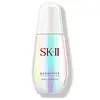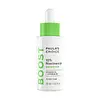What's inside
What's inside
 Key Ingredients
Key Ingredients

 Benefits
Benefits

 Concerns
Concerns

No concerns
 Ingredients Side-by-side
Ingredients Side-by-side

Water
Skin ConditioningGalactomyces Ferment Filtrate
HumectantNiacinamide
SmoothingButylene Glycol
HumectantTriethylhexanoin
MaskingPentylene Glycol
Skin ConditioningGlycerin
HumectantNylon-12
Phytosteryl/Octyldodecyl Lauroyl Glutamate
Skin ConditioningPolymethylsilsesquioxane
Boron Nitride
AbsorbentPanthenol
Skin ConditioningPEG-20 Sorbitan Cocoate
EmulsifyingInositol
HumectantCaprylic/Capric Triglyceride
MaskingMica
Cosmetic ColorantPhenoxyethanol
PreservativeAcrylates/C10-30 Alkyl Acrylate Crosspolymer
Emulsion StabilisingPEG-11 Methyl Ether Dimethicone
EmulsifyingPolyacrylamide
Aminomethyl Propanol
BufferingUndecylenoyl Phenylalanine
Skin ConditioningBenzyl Alcohol
PerfumingC13-14 Isoparaffin
EmollientDisodium EDTA
Hydrolyzed Prunus Domestica
Skin ConditioningXanthan Gum
EmulsifyingSodium Benzoate
MaskingHexyldecanol
EmollientLaureth-7
EmulsifyingCitrus Reticulata Peel Extract
Skin ConditioningMethylparaben
PreservativeAscorbyl Glucoside
AntioxidantPrunus Mume Fruit Extract
HumectantTocopherol
AntioxidantParfum
MaskingLimonene
PerfumingCitronellol
PerfumingLinalool
PerfumingGeraniol
PerfumingCI 77891
Cosmetic ColorantWater, Galactomyces Ferment Filtrate, Niacinamide, Butylene Glycol, Triethylhexanoin, Pentylene Glycol, Glycerin, Nylon-12, Phytosteryl/Octyldodecyl Lauroyl Glutamate, Polymethylsilsesquioxane, Boron Nitride, Panthenol, PEG-20 Sorbitan Cocoate, Inositol, Caprylic/Capric Triglyceride, Mica, Phenoxyethanol, Acrylates/C10-30 Alkyl Acrylate Crosspolymer, PEG-11 Methyl Ether Dimethicone, Polyacrylamide, Aminomethyl Propanol, Undecylenoyl Phenylalanine, Benzyl Alcohol, C13-14 Isoparaffin, Disodium EDTA, Hydrolyzed Prunus Domestica, Xanthan Gum, Sodium Benzoate, Hexyldecanol, Laureth-7, Citrus Reticulata Peel Extract, Methylparaben, Ascorbyl Glucoside, Prunus Mume Fruit Extract, Tocopherol, Parfum, Limonene, Citronellol, Linalool, Geraniol, CI 77891
Water
Skin ConditioningNiacinamide
SmoothingAcetyl Glucosamine
Skin ConditioningAscorbyl Glucoside
AntioxidantButylene Glycol
HumectantPhospholipids
Skin ConditioningSodium Hyaluronate
HumectantAllantoin
Skin ConditioningBoerhavia Diffusa Root Extract
Skin ProtectingGlycerin
HumectantDipotassium Glycyrrhizate
HumectantGlycyrrhiza Glabra Root Extract
BleachingUbiquinone
AntioxidantEpigallocatechin Gallate
AntioxidantBeta-Glucan
Skin ConditioningPanthenol
Skin ConditioningCarnosine
Skin ConditioningGenistein
Skin ConditioningCitric Acid
BufferingSodium Citrate
BufferingSodium Hydroxide
BufferingXanthan Gum
EmulsifyingDisodium EDTA
Ethylhexylglycerin
Skin ConditioningPhenoxyethanol
PreservativeWater, Niacinamide, Acetyl Glucosamine, Ascorbyl Glucoside, Butylene Glycol, Phospholipids, Sodium Hyaluronate, Allantoin, Boerhavia Diffusa Root Extract, Glycerin, Dipotassium Glycyrrhizate, Glycyrrhiza Glabra Root Extract, Ubiquinone, Epigallocatechin Gallate, Beta-Glucan, Panthenol, Carnosine, Genistein, Citric Acid, Sodium Citrate, Sodium Hydroxide, Xanthan Gum, Disodium EDTA, Ethylhexylglycerin, Phenoxyethanol
 Reviews
Reviews

Ingredients Explained
These ingredients are found in both products.
Ingredients higher up in an ingredient list are typically present in a larger amount.
Ascorbyl Glucoside is a stable form of Vitamin C. It is created by combining glucose from starch.
When applied to skin, Ascorbyl Glucoside turns into Ascorbic Acid.
Ascorbyl Glucoside is an antioxidant. Antioxidants help fight free-radicals, or molecules that may damage skin cells.
It can help to reduce redness, improve skin texture, reduce the effects of aging, reduce the visibility of dark spots, and brighten skin.
Read more about other types of Vitamin C:
Learn more about Ascorbyl GlucosideButylene Glycol (or BG) is used within cosmetic products for a few different reasons:
Overall, Butylene Glycol is a safe and well-rounded ingredient that works well with other ingredients.
Though this ingredient works well with most skin types, some people with sensitive skin may experience a reaction such as allergic rashes, closed comedones, or itchiness.
Learn more about Butylene GlycolDisodium EDTA plays a role in making products more stable by aiding other preservatives.
It is a chelating agent, meaning it neutralizes metal ions that may be found in a product.
Disodium EDTA is a salt of edetic acid and is found to be safe in cosmetic ingredients.
Learn more about Disodium EDTAGlycerin is already naturally found in your skin. It helps moisturize and protect your skin.
A study from 2016 found glycerin to be more effective as a humectant than AHAs and hyaluronic acid.
As a humectant, it helps the skin stay hydrated by pulling moisture to your skin. The low molecular weight of glycerin allows it to pull moisture into the deeper layers of your skin.
Hydrated skin improves your skin barrier; Your skin barrier helps protect against irritants and bacteria.
Glycerin has also been found to have antimicrobial and antiviral properties. Due to these properties, glycerin is often used in wound and burn treatments.
In cosmetics, glycerin is usually derived from plants such as soybean or palm. However, it can also be sourced from animals, such as tallow or animal fat.
This ingredient is organic, colorless, odorless, and non-toxic.
Glycerin is the name for this ingredient in American English. British English uses Glycerol/Glycerine.
Learn more about GlycerinNiacinamide is a multitasking form of vitamin B3 that strengthens the skin barrier, reduces pores and dark spots, regulates oil, and improves signs of aging.
And the best part? It's gentle and well-tolerated by most skin types, including sensitive and reactive skin.
You might have heard of "niacin flush", or the reddening of skin that causes itchiness. Niacinamide has not been found to cause this.
In very rare cases, some individuals may not be able to tolerate niacinamide at all or experience an allergic reaction to it.
If you are experiencing flaking, irritation, and dryness with this ingredient, be sure to double check all your products as this ingredient can be found in all categories of skincare.
When incorporating niacinamide into your routine, look out for concentration amounts. Typically, 5% niacinamide provides benefits such as fading dark spots. However, if you have sensitive skin, it is better to begin with a smaller concentration.
When you apply niacinamide to your skin, your body converts it into nicotinamide adenine dinucleotide (NAD). NAD is an essential coenzyme that is already found in your cells as "fuel" and powers countless biological processes.
In your skin, NAD helps repair cell damage, produce new healthy cells, support collagen production, strengthen the skin barrier, and fight environmental stressors (like UV and pollution).
Our natural NAD levels start to decline with age, leading to slower skin repair, visible aging, and a weaker skin barrier. By providing your skin niacinamide, you're recharging your skin's NAD levels. This leads to stronger, healthier, and younger looking skin.
Another name for vitamin B3 is nicotinamide. This vitamin is water-soluble and our bodies don't store it. We obtain Vitamin B3 from either food or skincare. Meat, fish, wheat, yeast, and leafy greens contain vitamin B3.
The type of niacinamide used in skincare is synthetically created.
Learn more about NiacinamidePanthenol is a common ingredient that helps hydrate and soothe the skin. It is found naturally in our skin and hair.
There are two forms of panthenol: D and L.
D-panthenol is also known as dexpanthenol. Most cosmetics use dexpanthenol or a mixture of D and L-panthenol.
Panthenol is famous due to its ability to go deeper into the skin's layers. Using this ingredient has numerous pros (and no cons):
Like hyaluronic acid, panthenol is a humectant. Humectants are able to bind and hold large amounts of water to keep skin hydrated.
This ingredient works well for wound healing. It works by increasing tissue in the wound and helps close open wounds.
Once oxidized, panthenol converts to pantothenic acid. Panthothenic acid is found in all living cells.
This ingredient is also referred to as pro-vitamin B5.
Learn more about PanthenolPhenoxyethanol is a preservative that has germicide, antimicrobial, and aromatic properties. Studies show that phenoxyethanol can prevent microbial growth. By itself, it has a scent that is similar to that of a rose.
It's often used in formulations along with Caprylyl Glycol to preserve the shelf life of products.
Water. It's the most common cosmetic ingredient of all. You'll usually see it at the top of ingredient lists, meaning that it makes up the largest part of the product.
So why is it so popular? Water most often acts as a solvent - this means that it helps dissolve other ingredients into the formulation.
You'll also recognize water as that liquid we all need to stay alive. If you see this, drink a glass of water. Stay hydrated!
Learn more about WaterXanthan gum is used as a stabilizer and thickener within cosmetic products. It helps give products a sticky, thick feeling - preventing them from being too runny.
On the technical side of things, xanthan gum is a polysaccharide - a combination consisting of multiple sugar molecules bonded together.
Xanthan gum is a pretty common and great ingredient. It is a natural, non-toxic, non-irritating ingredient that is also commonly used in food products.
Learn more about Xanthan Gum